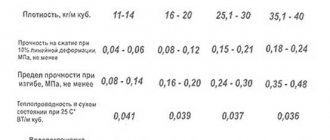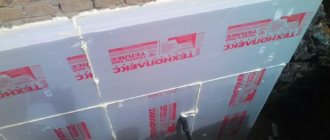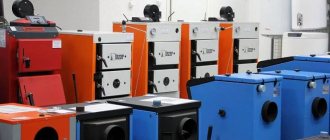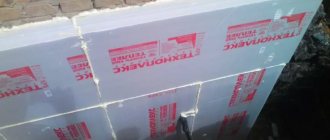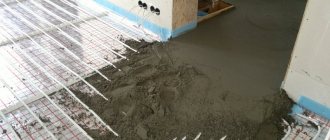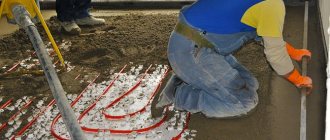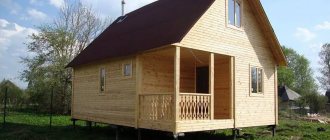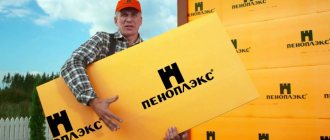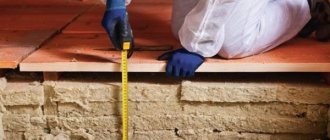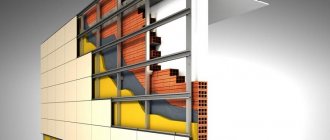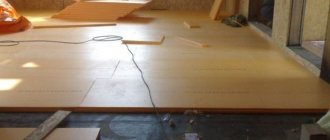The topic of today's article is floor insulation with penoplex. Here we will tell you about the material itself and how it can be used to insulate floor foundations in a private house, and we will also touch on the process of insulating walls with penoplex.
Floor insulation with Penoplex slabs Source altpol.ru
What is Penoplex
We must start with the fact that “Penoplex” is the name of a Russian trademark, which has gradually transformed into a common name for a building material. Essentially, it is extruded polystyrene foam, and nothing more.
That is, the production process of penoplex is as follows:
- polystyrene granules are melted with the addition of a special preparation - pyrophores, under the influence of which the resulting mass begins to foam;
- the foamed material is fed to the extruder, where it is passed under pressure through nozzles - slots of a certain thickness;
- the mixture cools and hardens;
- a tape is formed, which is cut into standard slab sizes.
The most important thing is that the material essentially consists of hollow granules with a diameter of 0.10.2 mm, which are pressed tightly against each other. In this case, the granules have a closed structure. Hence the high technical characteristics of penoplex.
The manufacturer today offered several models of material with different technical characteristics and has recently changed the labeling. So let's look at what the construction market offers.
Penoplex panels Source remontistrojka.com
Penoplex Wall
This brand of material is used to insulate walls with penoplex. Previously, it had a different name - Penoplex 31. There are so-called two subgroups in this brand, which differ from each other in the use of fire retardant compounds in the production process. So, the Penoplex-Comfort brand does not have them, but they are added to the Penoplex-Facade brand. That is, by adding a fire retardant, the flammability class of the material changes. Let us add that the “Facade” brand has higher strength characteristics.
And a few characteristics:
- density varies from 25 to 32 kg/m³;
- thermal conductivity – 0.03 W m/K;
- compressive strength – 0.2 MPa;
- water absorption 0.5%;
- temperature range: from -50C to +75C.
Just a few words about water absorption. Tests were carried out when a penoplex slab was completely immersed in sight for 18 days. So, during this time, the material gained only 0.6% moisture only due to open-type granules, which were located at the edges of the slabs in the places where they were cut. Therefore, penoplex is recommended for insulating walls and other structural elements in wet rooms.
Thermal insulation of the facade of a brick house with penoplex Source stroyka-ug.ru
Penoplex-Foundation
Old marking - Penoplex 35 without fire retardant additives. This model has a higher compressive strength, namely 0.27 MPa, so it is often used for thermal insulation of floors. Other characteristics:
- density: 29-33 kg/m³;
- water absorption – 0.5%;
- thermal conductivity 0.03 W m/K;
- operating temperature: -50C to +75C.
Penoplex for thermal insulation of foundations Source aleakrd.ru
Penoplex-Roof
From the name itself it becomes clear where these thermal insulation boards will be used. They are usually used to insulate both flat and pitched roofs. The insulation technology is different in the two cases. But in this article we are interested in another question, so we will simply designate the characteristics of this thermal insulation material:
- strength – 0.25 MPa;
- thermal conductivity – 0.03 W m/K;
- density – 28-33 kg/m³;
- water absorption – 0.5%.
Thermal insulation of a pitched roof with penoplex panels Source dmcp.ru
See also: Contacts of construction companies that specialize in the installation of engineering systems.
Floor insulation technology
So, having dealt with all the penoplex models, let’s move on to the main topic - insulation of floor bases with penoplex.
Let's start with the fact that in private housing construction, floor foundations come in three types: on the ground, in the form of a reinforced concrete slab, and wooden floors. Let's consider each option separately.
Insulation of floors on the ground
What is the construction of a floor on the ground? This is a section located between the strip foundation elements. To form a floor base, the space between the foundation elements is filled with either gravel, crushed stone, or sand, over which a thick reinforced screed is poured.
As for insulation, you need to approach this process a little differently:
- the soil is compacted so that the bulk materials poured onto it do not fall through in sections;
- crushed stone of the middle fraction with a thickness of 10-15 cm is poured in, which is also compacted;
- a sand layer 30 cm thick is poured with a tamper.
Insulation of the floor on the ground with penoplex Source pol-exp.com
Pay attention to the thickness of the sand. The thing is that moisture coming from below cannot overcome a sand layer more than 30 cm thick. And although penoplex is not afraid of water, it is worth taking care of this too.
So, the filling is ready. Penoplex slabs are laid on it in rows. It is important here to strictly follow the manufacturer’s recommendations. And they say that the panels in each row relative to the slabs of the other row should be located with an offset of half a slab. This way the heat-insulating layer will be evenly loaded. This is the first.
Secondly, a small gap of 2-3 cm is left between the foundation and the insulation boards, which will subsequently need to be filled with a special foam sealant.
The next stage in the formation of the floor base is pouring the screed. To do this, a reinforcing frame in the form of a finished galvanized mesh is laid on the foam slabs, which must be laid on stands to a height of 2.5 cm. After which a screed 5 cm thick is poured. That is, the mesh will be inside the screed exactly in the middle of the thickness, which is what is required to form a strong floor.
Some masters add two more layers to these layers:
- one is a waterproofing film, which is laid between penoplex slabs and a concrete screed;
- A screed 2-3 cm thick is poured under the insulation over the pillow.
The last layer is optional if the pillow was made according to all construction laws. Namely: it is leveled and compacted.
Subtleties and advice from professionals
In order to insulate the outside or inside with your own hands correctly, you need to take into account some of the nuances of the work:
- instead of polyethylene film for waterproofing, it is better to use a multilayer membrane;
- to insulate a wooden house from the inside, it is better to choose vapor-permeable types of materials;
- polystyrene foam must be laid tightly against the wall;
- there should be good ventilation in the room.
Penoplex insulation has its own characteristics, but if all installation rules are followed, the material will provide high-quality protection against heat loss and will last a long time.
Video description
In the video, the owner of a private house tells how floors were poured over the ground with the installation of penoplex slabs:
See also: Contacts of construction companies that specialize in the installation of stoves and fireplaces.
Insulation of a concrete slab
This technology belongs to the category - floor insulation for concrete under screed. In private housing construction, concrete floor slabs are not uncommon. More often, finished products are used for this; less often, a monolithic structure is poured. And although the second one is cheaper, there is less fuss with the slabs, and besides, they comply with GOST standards in terms of strength and reliability.
So what is gender in this case? These are reinforced concrete slabs laid on a foundation or on walls, between which there are often gaps. So, the latter must be filled with concrete mortar, with linings made of sheet material installed underneath.
The slabs themselves, or rather their surfaces, do not always meet the standards of evenness. That is, they have protrusions, depressions, and cracks that need to be gotten rid of. Typically, a repair cement-sand mortar is used for this. The main task is to bring the surface of reinforced concrete slabs to maximum evenness.
Floor slabs laid with gaps Source profrab.allgranite.com.ua
As for laying foam flooring under the screed, the slab material in this case must be fixed to the surface of the concrete base. To do this, you can use two methods:
- A special adhesive composition made for Penoplex boards.
- Mushroom screws. The latter are either driven or twisted products. We choose the first option. They are made of either plastic or steel. We choose the first option so as not to create cold bridges.
The method of attaching thermal insulation panels to the floor using self-tapping screws is simple. To do this, the panel is laid at the destination. Two holes are drilled through it with a drill and a drill so that holes for the dowel are created in the concrete floor. A dowel is inserted into the concrete base directly through the panel, into which a self-tapping screw is then simply driven with a hammer. It turns out to be a very reliable mount.
As for the holes, their location is in the middle of the width of the slab at a distance of 20-25 cm from the edge.
Forming a floor using a foam screed is done using the same technology mentioned above. That is, with the laying of a reinforcing frame.
Preparing the concrete base
The concrete floor must be leveled and cracks repaired.
Before attaching penoplex to the concrete on the floor, a number of measures should be taken to prepare the base. Ignoring this stage is fraught with rather unpleasant consequences.
- Dismantling the old coating. Cleaning the surface from debris and dust.
- Removing nails, screws, protruding reinforcement and other foreign objects.
- Carrying out measurements and inspection of the activity area. Determining the level of the subfloor, the presence of open seams, cracks and holes.
- Leveling the slab, sealing all openings with cement mortar or sealant.
- Sanding the floor. Removing all protrusions and uneven surfaces. The height difference should not be more than 1% per linear meter.
- Concrete primer. This procedure must be carried out at least twice to ensure deep penetration of the liquid.
Finally, a damper tape is installed around the perimeter of the room. It will provide space for thermal expansion of the insulation when heated. If there is no door, a board, plywood or steel profile is inserted into the opening, the height is designed to raise the floor level after laying the penoplex and pouring the screed.
Thermal insulation of walls with Penoplex
Let's start with the fact that the process of insulating walls with polystyrene foam boards requires one thing from this process. It consists in the fact that penoplex should be laid on the surface of the walls without gaps and air layers. That is, tight. This is what ensures high thermal insulation of walls.
Therefore, before starting the thermal insulation process, the surfaces of the walls must be leveled to the maximum. The easiest way is plastering or applying a layer of façade putty. In this way, the wall is not only leveled, but also repaired: cracks, chips and potholes are repaired, stains of paint and other materials are covered. Often craftsmen lay insulation directly on a brick wall. But at the same time they must be secured with self-tapping screws.
And one more point related to preparing walls for insulation is primer. The primer liquid will increase the adhesive qualities of the wall surface, which will create improved conditions for attaching penoplex to the walls with glue.
Finishing the facade with penoplex slabs Source 2gis.com
Compare with foam plastic
The question is quite reasonable: why buy expensive polystyrene foam, if you can buy cheap polystyrene foam - it is produced in the form of mats of the same thickness and size. But it's not that simple. These two insulation materials have significant differences, and polystyrene foam is inferior to expanded polystyrene in many respects:
- In terms of strength with the same thickness and density, it has been experimentally proven that penoplex is 4 times stronger than polystyrene foam, which is why it is used even in road construction.
- Due to its low density and special structure, foam is susceptible to crumbling.
- The degree of water absorption of polystyrene foam is 10 times higher than that of expanded polystyrene. It follows that penoplex can be used without vapor barrier.
- The density of penoplex is much higher than that of polystyrene foam.
- The thermal conductivity of penoplex is not much, but it is superior to polystyrene foam.
- The flammability of penoplex is lower.
Polystyrene foam is laid on a sand bedding
A special method for producing extruded polystyrene foam makes it possible to obtain a material with closed pores, so this material is definitely better than polystyrene foam.
Polystyrene foam in the body of the screed when pouring stairs
Briefly about the main thing
Having understood the topic - insulating a house with penoplex, it can be noted that the process itself is not so complicated. There are not many nuances and steps in it, because penoplex is a durable material in itself. It does not require frames or complex sheathing designs. It is simply laid on the insulated surface and attached to it with glue and self-tapping screws. If gaps remain between the slabs during the installation process, they are filled with a special foam sealant. This is not polyurethane foam, because the sealant does not expand in volume.
Required thickness parameter
To insulate the outside of the house with penoplex with your own hands, you need to choose the appropriate thickness of the product. Here you should pay attention to the climate zone. When purchasing penoplex, insulation is carried out taking into account the fact that the insulating cake must provide a total heat transfer resistance of no less than that established in building codes and regulations.
For the calculation, the thermal conductivity coefficient of the insulation is additionally required. To find out the thickness of penoplex , you can use the following formula: P (thickness, m) = R (heat transfer resistance, which can be taken from official SNiP sources) * k (thermal conductivity index).
